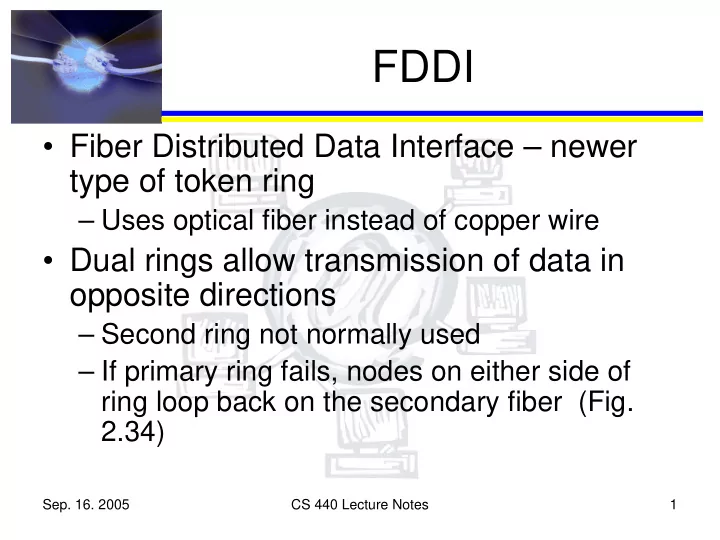

FDDI • Fiber Distributed Data Interface – newer type of token ring – Uses optical fiber instead of copper wire • Dual rings allow transmission of data in opposite directions – Second ring not normally used – If primary ring fails, nodes on either side of ring loop back on the secondary fiber (Fig. 2.34) Sep. 16. 2005 CS 440 Lecture Notes 1
FDDI (cont.) • Simpler single-attachment stations (SAS) allowed – concentrator used to attach them to ring – Concentrator includes optical bypass switches to isolate failed nodes • Each station buffers between 9 and 80 bits – Stations can have different buffer sizes – Station can start sending before buffer is full Sep. 16. 2005 CS 440 Lecture Notes 2
Physical Properties • Data rate 100 Mbps • Uses 4B/5B encoding • Limited to 500 stations per network • Max. 2 km between stations • Total limit of 200 km of fiber – Limits total distance between stations to 100 km • Can also run on coax or twisted pair Sep. 16. 2005 CS 440 Lecture Notes 3
Timed Token Algorithm • Define target token rotation time (TTRT) that all nodes agree to meet – Gives upper bound on TRT – Each node measures TRT – if token arrival is outside TTRT, node does not transmit data – If token arrival is early, node can hold token to delay it • This can still lead to starvation for some nodes Sep. 16. 2005 CS 440 Lecture Notes 4
Timed Token Algorithm (cont.) • To address, give frames one of two priorities, synchronous or asynchronous – Node can send synchronous frames even if token arrives late – But … total amount of synchronous data that can be sent in one token rotation is limited. Can only add one additional TTRT’s delay Sep. 16. 2005 CS 440 Lecture Notes 5
Token Maintenance • All nodes monitor to make sure token still present on ring – If a node hasn’t seen a frame or token for too long, it sends a claim frame – Claim includes a bid for the TTRT the node needs to meet any app. timing constraints – If claim makes it back to sender, sender knows bid was lowest, and the node has the token Sep. 16. 2005 CS 440 Lecture Notes 6
Token Maintenance (cont.) – If a node receives a claim and has a higher TTRT, updates TTRT to the one in the claim – If the node has a lower TTRT, node replaces the claim frame with its own – Ties broken by “highest address wins” – After a claim finally makes it unmodified back to its sender, that sender has the token, and everyone agrees on TTRT Sep. 16. 2005 CS 440 Lecture Notes 7
Frame Format 8 8 48 48 Variable 32 8 8 End Frame Start Dest Src Control Body CRC Delimiter Status Delimiter Address Address • Start and end delimiters use invalid 4B/5B codes • Bit in the header indicates synchronous or asynchronous traffic • Doesn’t include access control bits of 802.5 Sep. 16. 2005 CS 440 Lecture Notes 8
Recommend
More recommend